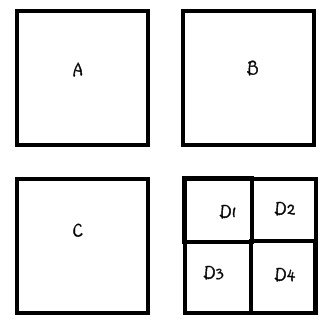 SUCCESSION PLANTING is the term gardeners use to refer to planting something else in place when a previous crop is all finished.
SUCCESSION PLANTING is the term gardeners use to refer to planting something else in place when a previous crop is all finished.
To pull this off effectively, you need a few things:
1. A diagram of your garden with zones marked off and numbered/lettered/named for old boyfriends, whatever…
The one above is of four of my beds 4×4 each–entirely one veggie for the first three and 2×2 blocks of different veggies in the last one.
2. Your Spring and Fall Garden Planners that tell you what you can plant when.
3. A CHART! (BTW, one of you lovely readers asked me to do this. How could I turn down another opportunity to make a chart? I LUV charts!)
If you want to print the pdf and fill it out by hand, click here.
If you want to download my Excel spreadsheet and type/customize it, click here.
A. On the left side, fill in your frost dates for spring and fall and write in the dates for the rest of the weeks. (copy from your planners.)
B. Notice that there is a gray area between Fall and Spring. That’s where the seasons overlap. It’s just “carrots, bush beans, and lettuce” over and over and over and over…. Depending on your dates there will be more or less weeks in your ‘gray area.’ (On mine, there are seven weeks between where spring left off and fall picked up.)

C. Put your garden section labels at the top.

D. And write in the blanks what you planted, and when.
E. Check the lists at the bottom of the chart and find out how long each crop will be in the ground.
F. Here’s the best part!!!
Ivory
P.S. I need professional help, don’t I?
P.P.S. Actually, I already have professional help…must be a permanent condition.
Thanks for this! 🙂
You are WELCOME!
I’ve been making maps and using your charts and planners obsessively. Thanks tons for setting this up! I’ve posted your link in a couple different gardening forums, the people there really love them too.
YAY!!!! I HEART CHARTS!!!! Thank you for sharing the links. Us obsessive chart-lovers have to stick together!
Have I mentioned how awesome and amazing these charts are? THIS IS THE YEAR I GET MY GARDENING ACT TOGETHER. (Had to shout that out to make it real.) I will plant on time. I will water. I will plant all summer long. I will have a FALL GARDEN. (Duh- last year I thought you planted Fall Gardens in…the fall.) *blush*
I heart your charts, too!!
Myrnie – I thought Fall Gardens were planted in fall, also. *sigh* I’m a city girl 🙂
I just stumbled across this when searching for succession planting info, and even though I read your blog, I didn’t start until well after this was published and I am so thankful for all the work you put in, since I would have tried to do it all from scratch and given myself a headache in the process. Thanks so much!
This is ridiculously awesome. Thanks!